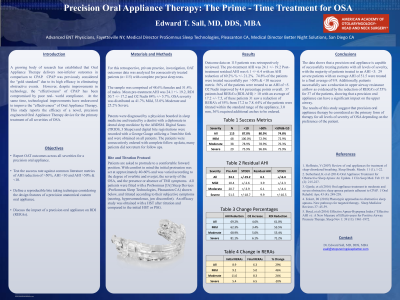Sleep Medicine
(394) Precision Oral Appliance Therapy: The Prime-Time Treatment for OSA
Monday, October 2, 2023
2:45 PM - 3:45 PM East Coast USA Time

Has Audio

Edward Sall, MD, DDS, MBA
Medical Director
ProSomnus Sleep Technologies and Advanced ENT Physicians of CNY
Fayetteville , New York, United States
Presenting Author(s)
Disclosure(s):
Edward Sall, MD, DDS, MBA: No relevant relationships to disclose.
Introduction: A growing body of research has established that Oral Appliance Therapy delivers non-inferior outcomes in comparison to CPAP. CPAP was previously considered the "gold standard" due to its high efficacy in eliminating obstructive events .The "effectiveness" of CPAP has been compromised by poor real-world compliance. . This study reports the efficacy of a novel, precision engineered Oral Appliance Therapy device for the primary treatment of all severities of OSA.
Methods: The sample was comprised of 48.6% females and 51.4% males. Mean pre-treatment AHI was 24.1 +/- 19.2, RDI 30.7 +/-17.2 and O2 Nadir 84% +/-5,7%. OSA severity was distributed as 41.7% Mild, 33% Moderate and 25.2% Severe.
Patients were diagnosed and treated by a board-certified sleep physician and Otolaryngologist, Digital Scans (Trios, 3 Shape) and digital bite registrations were recorded and were obtained on all patients. Patients were asked to protrude to a comfortable forward position. All patients were fitted with a ProSomnus {IA} Sleep Device, and titrated according to their subjective symptoms (snoring, hypersomnolence, jaw discomfort). An efficacy study was obtained with a HST after titration and compared to the initial HST or PSG.
Results: Outcome data on 115 patients was retrospectively reviewed. The pre-treatment AHI was 24.1 +/- 19.2. Post- treatment residual AHI was 6.1 +/-6.4 with an AHI reduction of 69.2% +/- 21.2%. 74.8% of the patients were treated successfully per> 50% & < 10 success metric. 56% of the patients were treated to an AHI of < 5. O2 Nadir improved by 4.6 percentage points overall. 64% of the patients were titrated within the standard range of the appliance, 3.0mm, 36% required additional arches to be ordered.
Conclusions: The data shows that a precision oral appliance is capable of successfully treating patients with all levels of severity with the majority of patients treated to an AHI < 5. 29 severe patients with an average AHI of 51.5 were treated to a final average of 9.9. The results of this study suggest that precision oral appliance therapy be considered for all levels of severity of OSA depending on the preference of the patient.
